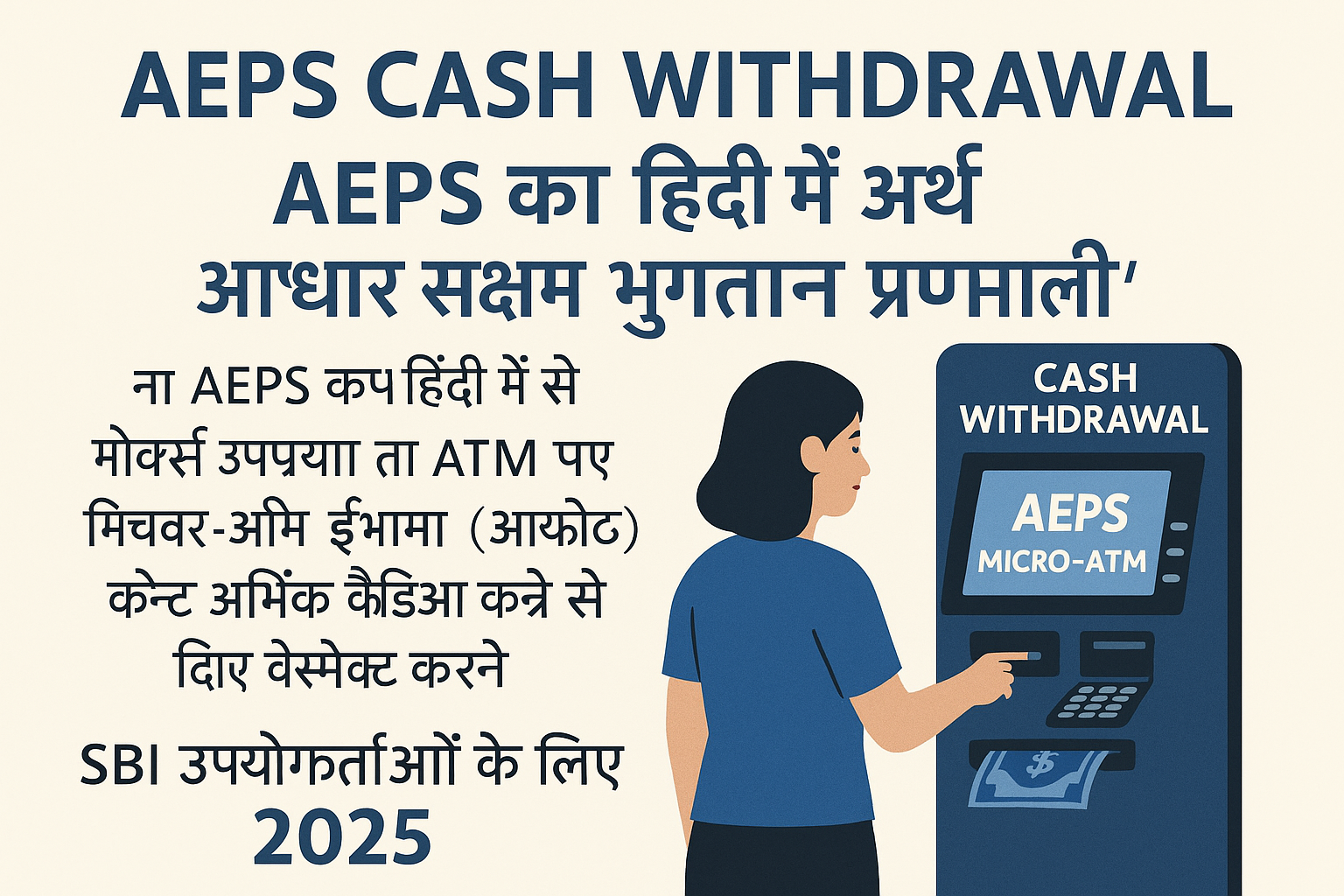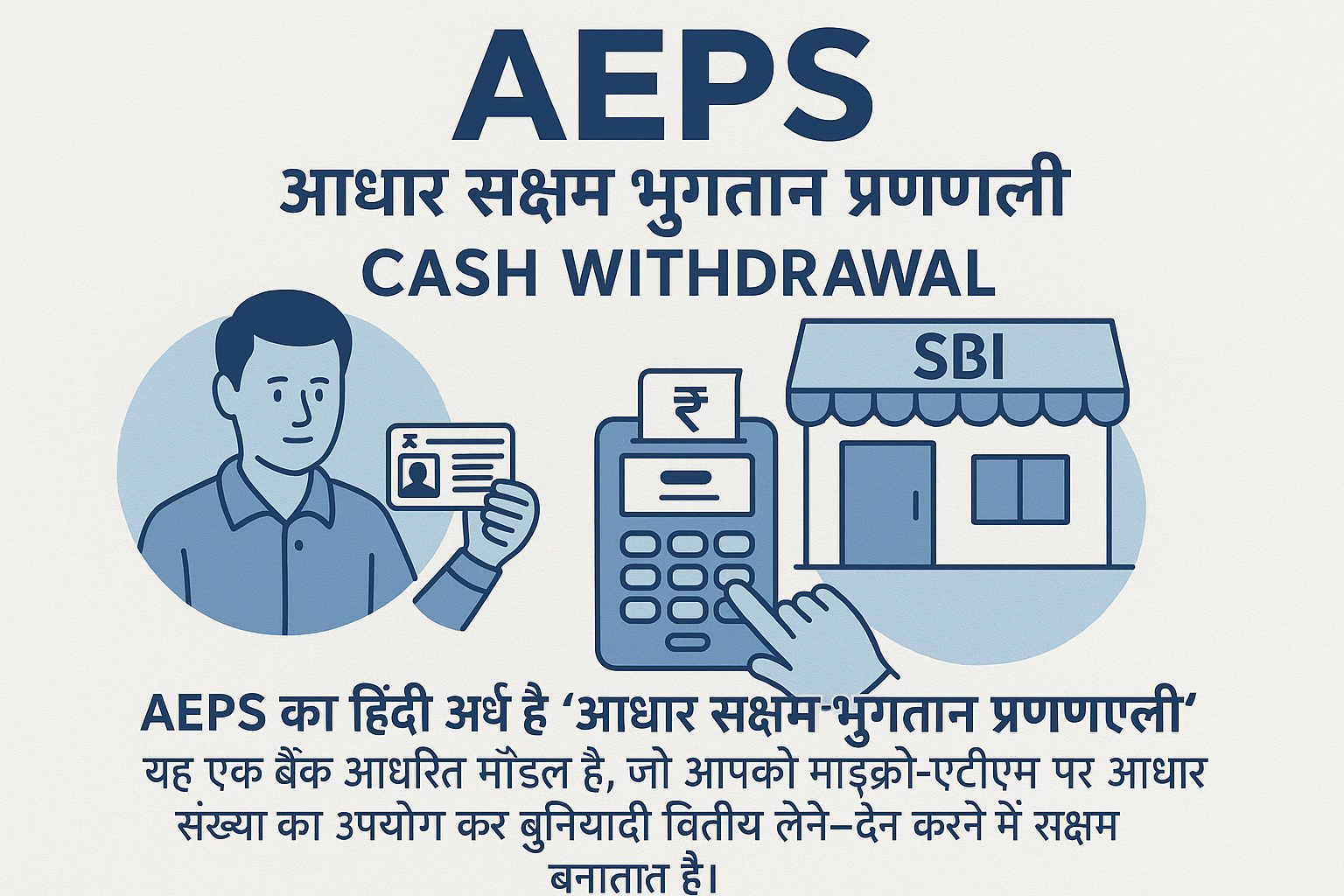In the ever-evolving landscape of Indian banking, a simple yet powerful concept has been changing how millions access their money: AEPS Cash Withdrawal. For State Bank of India (SBI) customers, understanding this service is key to unlocking a world of convenient, card-less banking. So, what exactly is this service that’s becoming a cornerstone of financial inclusion? Let’s dive deep into the AEPS cash withdrawal meaning in Hindi and explore everything an SBI user needs to know in 2025.
AEPS का हिंदी अर्थ है “आधार सक्षम भुगतान प्रणाली” (Aadhaar Saksbh Bhagtan Pranali). In simple terms, it’s a bank-led model that allows you to use your Aadhaar number to carry out basic financial transactions at a Micro-ATM (which is often a Kirana store or a Business Correspondent – SBI Khidmat Centre), just like you would at an ATM, but without needing your debit card or phone.
Breaking Down the Basics: What is AEPS?
Imagine you’re in a remote village, you’ve forgotten your wallet and phone at home, but you urgently need cash. A few years ago, this would have been a major problem. Today, thanks to AEPS, it’s not. The entire system is built on the backbone of your Aadhaar and its linked bank account.
For an SBI customer, AEPS means you can walk up to any authorized Aadhaar-enabled payment terminal (like an SBI Khidmat Centre or a merchant enrolled under the NPCI), authenticate yourself with your fingerprint, and perform transactions. The core services offered are:
-
Cash Withdrawal: The most popular service.
-
Cash Deposit: Depositing money into your account.
-
Balance Enquiry: Checking your SBI account balance.
-
Mini Statement: Getting a quick summary of recent transactions.
The beauty of AEPS lies in its interoperability. You don’t need an SBI-specific terminal. You can use a terminal run by a BC of another bank to access your SBI account, making it incredibly versatile.

The Step-by-Step Process for SBI AEPS Cash Withdrawal
Let’s make it practical. Here is how you, as an SBI customer, would withdraw cash using AEPS in 2025:
-
Locate a Micro-ATM/BC Point: Find a nearby SBI Khidmat Centre, CSP (Customer Service Point), or any local merchant displaying “Aadhaar Enabled Payment System” or “AEPS” signage.
-
Provide Your Aadhaar Number: Tell the merchant or agent your 12-digit Aadhaar number. Always ensure you are at a legitimate and trusted outlet.
-
Select Your Bank: The agent will select “State Bank of India” from the list of banks on their machine.
-
Choose Transaction Type: Select “Cash Withdrawal.”
-
Enter the Amount: Specify the amount you wish to withdraw, keeping in mind the daily transaction limits.
-
Biometric Authentication: This is the most crucial security step. Place your finger on the biometric scanner connected to the machine. The system will verify your fingerprint against the one stored in the Aadhaar database.
-
Authorization and Receipt: Once your fingerprint is verified, the transaction is authorized. You will receive a printed receipt confirming the withdrawal, the transaction ID, the amount debited, and your updated balance (if applicable).
The money is debited directly from your SBI account linked to your Aadhaar. This is why it’s vital to ensure your Aadhaar is successfully linked with your SBI savings or current account.
Why is AEPS a Game-Changer for SBI Customers in 2025?
As we move further into the digital age, AEPS remains relevant for several compelling reasons:
-
Financial Inclusion: It brings banking services to the doorsteps of people in rural and semi-urban areas who may not be comfortable with smartphones or digital apps.
-
Card-Less Convenience: You no longer need to carry and risk losing your debit card. Your finger is your key.
-
Interoperability: As mentioned, you are not restricted to SBC BC points alone. This widespread network makes cash access ubiquitous.
-
Security: Biometric authentication (fingerprint) is extremely difficult to forge, making it more secure than a PIN that can be guessed or stolen.
-
Zero Balance Account Friendly: AEPS works perfectly for customers with basic savings bank accounts (BSBDA) that have a zero-balance facility.
According to the National Payments Corporation of India (NPCI), AEPS transactions have consistently shown growth, processing hundreds of millions of transactions monthly, a testament to its deep penetration and utility.

SBI AEPS in 2025: Charges, Limits, and Important Considerations
While AEPS is a boon, it’s essential to understand the fine print to use it effectively.
-
Transaction Limits: The daily cash withdrawal limit for AEPS is set by NPCI and is generally around ₹10,000 per transaction and ₹50,000 per day across all banks. However, SBI may have its own specific sub-limits. It’s always best to check with your home branch or the BC at the time of transaction.
-
Charges: One of the biggest advantages has been the low cost. For cash withdrawals, the NPCI mandates a small interchange fee. While SBI does not directly charge its customers for AEPS transactions through its own BCs, the Business Correspondent (the shopkeeper/agent) may charge a nominal fee for their service, especially in remote areas. This is typically a small, fixed amount (e.g., ₹5 to ₹15 per transaction) and should be transparently communicated.
-
Prerequisite – Aadhaar Linking: Your Aadhaar number must be linked to your SBI account for AEPS to work. You can link it via Internet Banking (SBI NetBanking), the YONO app, by visiting an SBI ATM, or by submitting a form at your branch.
AEPS vs. UPI: Which One Should You Use?
In 2025, with UPI’s dominance, this is a valid question. Here’s a quick comparison:
| Feature | AEPS (Aadhaar Enabled Payment System) | UPI (Unified Payments Interface) |
|---|---|---|
| Primary Use | Cash-based transactions (Withdrawal, Deposit) | Digital, cash-less payments & transfers |
| Authentication | Biometric (Fingerprint) | UPI PIN (set by user) |
| Requirement | Aadhaar-linked Bank Account | Smartphone, Bank Account, Debit Card, Internet |
| Best For | People without smartphones, cash withdrawals in remote areas, senior citizens | Tech-savvy users, online/offline merchant payments, peer-to-peer transfers |
Verdict: AEPS is not a competitor to UPI but a complement. It serves a different demographic and use-case, ensuring no one is left behind in the financial ecosystem.
The Future of AEPS with SBI
Looking ahead to 2025 and beyond, we can expect AEPS to become even more seamless. Integration with newer, low-cost biometric devices, enhanced security protocols, and potentially higher transaction limits to keep up with inflation are all on the cards. It will continue to be the bedrock of accessible banking for a significant portion of India’s population.
### Frequently Asked Questions (FAQs)
1. क्या एईपीएस के लिए इंटरनेट की आवश्यकता होती है? (Does AEPS require an internet connection?)
Yes, the Micro-ATM device used by the Business Correspondent requires an internet connection to authenticate your Aadhaar and process the transaction in real-time.
2. अगर मेरी उंगली का निशान स्कैन नहीं हो रहा है तो मैं क्या करूं? (What if my fingerprint is not scanning?)
This is a common issue, especially for people with worn-out fingerprints. You can try a different finger. If it persists, you must visit your SBI branch to update your biometrics in the Aadhaar database. You cannot use AEPS until your biometrics are successfully verified.
3. क्या एईपीएस के जरिए पैसे निकालने की कोई फीस है? (Is there any fee for withdrawing money through AEPS?)
SBI does not charge you directly. However, the Business Correspondent (agent) may levy a small, transparent service charge for the cash withdrawal.
4. एईपीएस ट्रांजैक्शन असफल होने पर पैसे कब तक वापस मिलेंगे? (How long for a refund for a failed AEPS transaction?)
In case of a failed transaction where money was debited from your account, it is typically automatically reversed within 5-7 working days. If it doesn’t, you should immediately contact your SBI branch with the transaction receipt.
5. क्या मैं किसी भी बैंक के माइक्रो एटीएम से अपने एसबीआई खाते से पैसे निकाल सकता हूं? (Can I withdraw from my SBI account using any bank’s Micro-ATM?)
Yes, absolutely. AEPS is an interoperable platform. You can use a Micro-ATM of any bank’s BC to access your SBI account.
Disclaimer: This article is for educational and informational purposes only. The information provided about AEPS cash withdrawal, including charges and limits, is based on data available in the public domain and is subject to change as per the policies of the State Bank of India (SBI) and the National Payments Corporation of India (NPCI). Readers are advised to confirm the latest details from their local SBI branch or the official SBI website before proceeding with any transactions. The author and publisher are not responsible for any financial loss or inconvenience arising from the use of this information. If you have any concerns regarding the content of this post, please refer to the DMCA policy and takedown guide available on this website for resolution.
